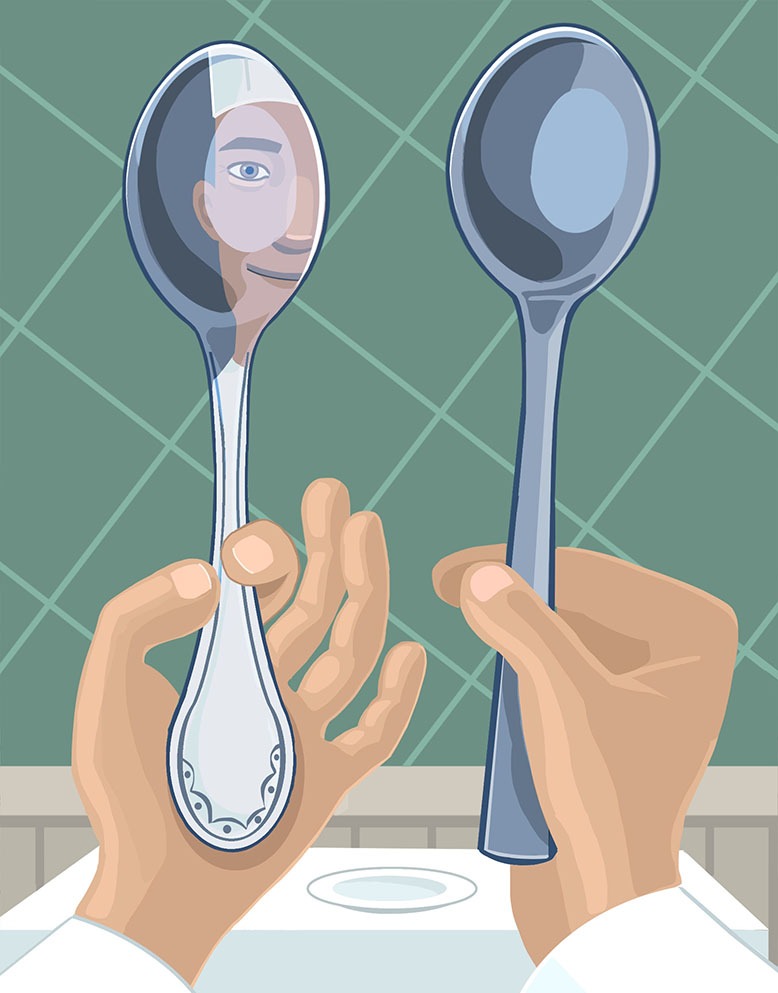
Illustration by Alison Seiffer
How welcoming is it to walk into a restaurant and see tables set with fine glasses and silverware, crisp cloth napkins and gleaming plates?
“It’s the first element of hospitality,” says Marc Pascal, co-owner of Stage Left Steak and Catherine Lombardi restaurants in New Brunswick. “You want to have in front of you the things you need.”
Fine-dining establishments see tablescape as second only to the sine qua nons of food and service. Tablescape denotes a process akin to furnishing a house or staging a play. The objects on the table send a message about the personality of a place and the story about to unfold.
“The tabletop allows you to complete the vision of what you want the customer to experience,” says Jeanne Cretella, president of Landmark Hospitality, which owns more than a dozen venues, including Liberty House in Jersey City, Stone House at Stirling Ridge in Warren, and the Ryland Inn in Whitehouse Station. “That china should look like it was made for the room.”
Robert N. Lange kept those very things in mind when he opened Rosie’s in Ocean Gate this summer. “It’s a little beachy, a little upscale, coastal modern,” he says. He decided on serene white plates and bowls in various shapes and sizes. “We have a cool dish for our dumplings,” he says. “It’s S-shaped, with cups built in for sauces.”
At the upscale Saddle River Inn, chef/owner Jamie Knott sets the appropriate tone with high-end porcelain dishes from Bauscher (founded in Germany, 1881), stemware from Schott Zwiesel (Germany, 1872), stainless flatware from Fortessa, and French steak knives from Laguiole. Knott sets a more playful tone at his Saddle River Café. “We use the river as a point of interest,” Knott says. “So the plates have a blue rim.” He uses stemless wineglasses for patio seating, but more traditional stemware indoors.
Pascal sets out dishes by Corby Hall, a Randolph-based company whose porcelain is made in Europe, as well as covered dishes (cloches) by Le Creuset. “I love cloches because they hold the heat, and you get a nose full of the smell of the food when you open them,” Pascal says. “So in a dish where we use truffles, or snails, foie gras, anything really aromatic, there will often be a cloche.”
At Steve & Cookie’s in Margate, “we have a tomato-salad plate, a hummus plate, a brussels sprouts plate,” says owner Cookie Till. “It’s definitely evolved over the years. We had basic round plates when we opened 25 years ago.” Now, she says, they’re using “square and rectangular plates, and some gorgeous greens.” The switch coincided, she explains, with the addition of Asian-influenced fare on the menu.
“I like a well-made, round, white plate,” says Brian Held, chef-owner of Brian’s in Lambertville. “Like Chanel, it’s a classic.” Held uses Bernardaud porcelain from France (established 1863). Held initially sourced it through the Waldorf Astoria collection salvaged by Olde Good Things, an antiques dealer in Scranton, Pennsylvania. “With fine French china, the problem, obviously, is breakage,” Held says. “We put it through the dishwasher, because we’ve broken more washing by hand.”
Breakage is an omnipresent problem. Cretella’s restaurants rely on chip-resistant tableware from Steelite, the British ceramics company. “You have to consider, does the weight allow us to carry three plates with grace?” she says, adding, “If it lasts a year or two, you’re lucky.” Knott says tiny appetizer forks and demi spoons are frequently lost. “They’re like the second sock in the dryer,” he says. Adds Till, “Oh my God, the breakage, the wine glasses. We are constantly ordering more.”
Stage Left Steak is renowned for its wine list, and its stemware collection includes exquisite goblets by Jancis Robinson. “They break if you whisper at them,” says Pascal. But co-owner Francis Schott maintains that the thin crystal goblet, with its sheer rim, is optimal for wine tasting. “It’s a design that is simple, beautiful and functional,” he says.
Pascal sees an economic benefit to paying well to retain long-term employees, who then feel they have a stake in the success of a restaurant. “Most of the time, it’s a new employee who breaks a glass or loses a piece of silverware in the garbage,” he says. “If you have high turnover, you’ll have a breakage and shrinkage problem at a much greater rate.”
For Held, budgeting about $2,500–$5,000 each year to replace tableware “is not a huge expenditure.” Knott says it cost him an initial $15,000 to $30,000 to stock his 85-seat Saddle River Inn and the 114-seat Saddle River Cafe. “But once you get past the initial clip, it’s not a huge deal.”
To keep costs down, Held no longer splurges on items easily lost or stolen. “I once bought 30 Laguiole knives, and they were gone in days,” he says. Steak knives from Laguiole retail for about $100 each. Instead, he uses stainless steel flatware that provides a pleasing heft, rather than what he terms an “Olive Garden feel.”
“The biggest epiphany I had,” says Till, “was with silverware. A guest said something like, ‘You’re fine dining, and this is pretty crappy.’ And they’re right. You can get leather-bound menus, but I’d rather put the money into the food. But I realized, Wow, I need to up my game.”
So Till ditched the ho-hum silverware and bought a weighted, more formal set. She doesn’t remember the brands she used, but is happy to report there have been no further complaints.
No one knows New Jersey like we do. Sign up for one (or more!) of our newsletters to get the best of where we live sent to your inbox every week. Want a print magazine mailed to your home? Purchase an issue from our online store.
The post Feast Your Eyes: How Chefs Set Enticing Tables appeared first on New Jersey Monthly.
